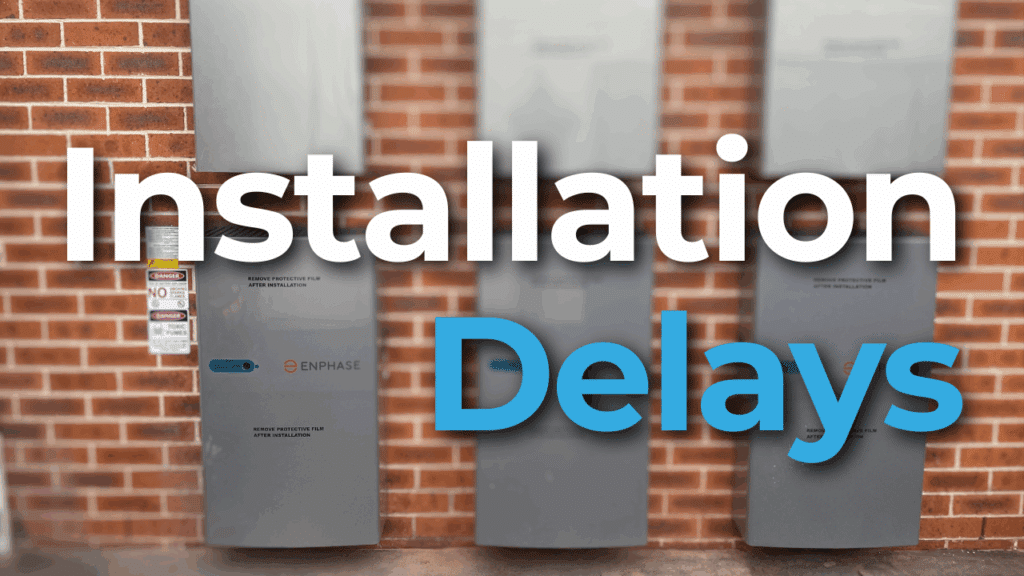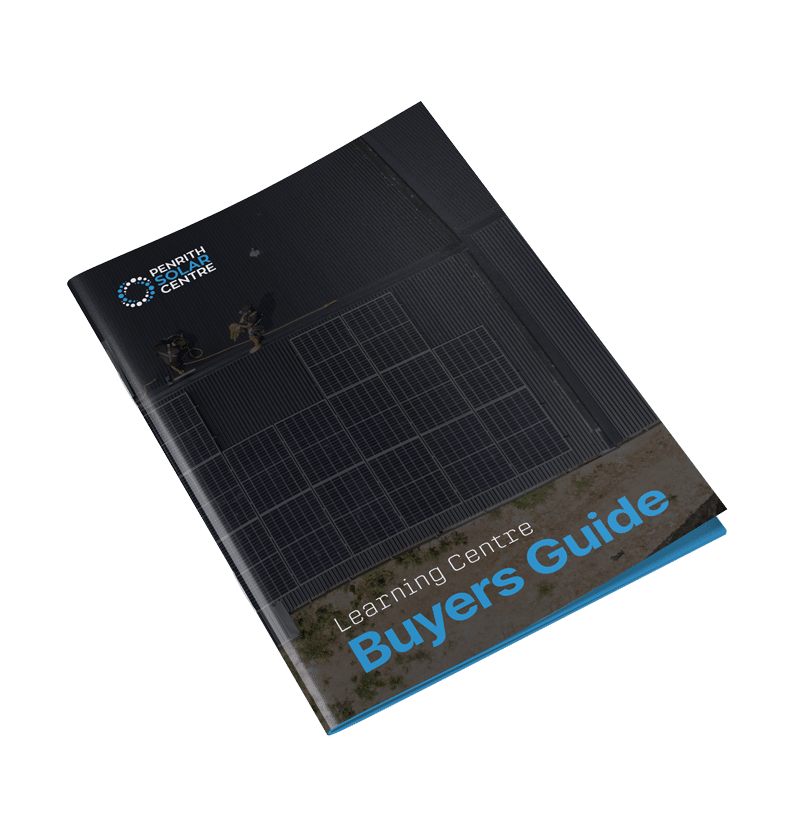
Thinking about getting a solar battery installed? You’re not alone. Since the Australian government launched the Cheaper Home Batteries program on July 1, demand has skyrocketed. Households across the country are taking advantage of the rebate, hoping to reduce their power bills and store solar energy at home.
But if you’ve already spoken to a solar company, you might have heard about something frustrating: wait times.
Some customers are being informed that it could take weeks (in some cases, months) to have their system installed.
Installers like PSC Energy are working flat out. Still, there are limits on the number of systems we can legally install in a day. These limits exist to keep the industry safe, honest, and fair.
We’re not here to make excuses today; however, there are reasons for this backlog. We’re here to inform you of those reasons.
In this article, you’ll learn about the following:
- How the Solar Industry is Installing Solar Batteries
- The Rules: What Installers Can and Can’t Do Per Day
- What Counts as ‘Ready to Commission’?
- How Compliance Is Tracked (Selfies Are Involved)
- Why These Rules Exist and Why Breaking Them Isn’t Worth It
- FAQ: Solar Battery Installation Delays
By the end of this article, you’ll learn why rebate installation rules exist, what they mean for your installation timeline, how solar companies stay compliant, and what you can do while you wait.
Let’s take a closer look at what’s happening behind the scenes.
How the Solar Industry is Installing Solar Batteries
The Cheaper Home Batteries program is a big deal. It offers households a discount upfront when they install a battery system, approximately one-third off the total cost.
This initiative aims to help more Australians store solar energy and reduce their reliance on the grid. The rebate is part of a broader effort by the government to support clean energy through the Small-scale Renewable Energy Scheme, or SRES.
Because of this new rebate, the entire industry is flooded with work. More people want systems, and they want them fast.
That might sound like a good problem to have, but the rush has created real pressure for us. We need to manage high demand, adhere to safety rules, and avoid making costly mistakes.
We can’t simply take on more jobs to meet the demand. There are legal limits on the number of installations we can complete each day.
These rules come from Solar Accreditation Australia (SAA), which sets the standards for the installation of solar and battery systems.
If we break these rules, we risk losing our accreditation. That’s why it may take longer to install your system than you expected. There are just so many rules to follow.
The industry is growing, but growth needs to happen the right way. Installers need to follow the rules, and that means doing fewer jobs per day, even when customers are eager and the phone won’t stop ringing.
And ringing off the hook is the only way to describe it.
We have a backlog because our values deliver a premium service. You know it, because you worked with us. We just ask that you be a little patient.
We still deliver the best or nothing. We’re just delivering an awful lot of it this July.
If you’re interested in learning a bit more about the importance of a good installer for your solar (the most important component of any system, seriously), you might want to check out the following article titled, In-house Installers vs. Subcontractors: Which is Better?
The Rules: What Installers Can and Can’t Do Per Day
Every installer who wants to claim rebates must follow daily installation limits. These limits are strict and exist to make sure each system is installed safely and correctly.
They also help stop fraud and protect the quality of the work.
From now until 1 August 2025, the rules say that one accredited installer can only sign off on the following combinations each day:
- Two solar battery systems, or
- Two solar power systems, or
- One solar power system and one battery system, or
- One solar system and two “ready to commission” batteries, or
- One battery system and two “ready to commission” batteries, or
- Up to four “ready to commission” battery installations
So, what does “ready to commission” mean?
It means the installer already did most of the work on installing the battery system earlier. All that’s left is final testing and turning it on.
If your battery was partially installed before 1 July, it can still qualify for the rebate, provided it wasn’t fully turned on before that date.
Then, starting on August 2 2025, the rules become simpler. An installer will only be allowed to complete:
- Two solar systems, or
- Two battery systems, or
- One solar system and one battery system per day
Solar Accreditation Australia sets these daily limits. They are tied to the number of Small-scale Technology Certificates (STCs) an installer can claim.
STCs are digital credits that enable rebates to be possible. If an installer exceeds their daily limit, they can’t claim those STCs, and that could result in thousands of dollars in lost revenue. It could also lead to an audit or investigation.
These rules aren’t flexible. Even if we could physically do more jobs in a day, legally, we can’t. That’s why you might be told to wait a little longer for your installation date.
If you’re interested in learning a bit more about working with a solar installer, you might want to check out the following article titled, Top Questions to Ask Your Solar Installer Before Hiring Them.
What Counts as ‘Ready to Commission’?
A “ready to commission” battery isn’t yet finished with its installation, but is nearing completion. The installer has already done the first two stages:
- Job setup: This includes planning the job, preparing the site, and starting installation.
- Mid-installation work: This refers to the stage where the battery has been physically installed and wired, but it hasn’t been tested or activated yet.
What’s left is just the final step: testing and commissioning. This is when the installer makes sure the battery is safe, connected properly, and ready to start working.
If the battery was installed before 1 July but has not been fully commissioned yet, it still qualifies for the Cheaper Home Batteries rebate. That’s why some installers are now revisiting older jobs to complete them, as they are considered “ready to commission” under the rules.
Why does this matter to you?
These types of jobs give installers a little more flexibility. Instead of just two full installs a day, they can add on up to four of these ready-to-go systems.
It helps installers get more done without breaking the rules. However, it only works if the earlier work was completed before 1 July and the system had not been activated yet.
So, if your installer tells you they’ll be back to “commission” your system, this is what they mean. It’s the final step, and it’s key to making sure your rebate is processed correctly.
If you’re interested in learning a bit more about the importance of your roof type and how it affects your solar installation, you might want to check out the following article titled, How Does Your Roof Affect Your Installation?
How Compliance Is Tracked (Selfies Are Involved)
If there are limits on how many systems an installer can complete in a day, what’s stopping them from ignoring the rules and claiming they did fewer?
The answer is photos. Installers must take time-stamped pictures at every stage of the job. These selfies are proof that the work was completed when they said it was.
Here’s how it works:
Installers take several photos during the job. These include shots taken at the beginning, during installation, and when the system is finished.
- The final photo must match the test date on the official electrical certificate. These aren’t casual photos either. They must be clear, detailed, and time-stamped.
- Each photo also includes hidden data, known as metadata. This is digital information stored in the photo file. It includes the exact date and time the photo was taken.
- It can also include GPS location if the photo was taken on a phone or camera with that feature.
- Inspectors can check this metadata to confirm when and where the work was done.
- If an installer tries to claim they installed fewer systems on a certain day, but the photos tell a different story, the Regulator will find out.
- This method helps catch people who try to cheat the system.
Battery installations now follow these rules. Installers must submit time-stamped photos for these jobs. This keeps everything consistent and helps the Clean Energy Regulator track who is following the rules.
When your installer pulls out their phone and snaps a selfie in front of your solar system, they’re not updating their socials; they’re protecting their license, their business, and your rebate.
If you’d like to learn more about that, we suggest you check out the following article titled, How Long Will My Solar Install Take?
Why These Rules Exist and Why Breaking Them Isn’t Worth It
The daily installation limits might feel frustrating, especially if you’re waiting for your system to come online. But these rules exist for good reasons.
First, they protect safety.
- Rushing through installs increases the chance of mistakes. A poorly installed battery can lead to electrical faults, system failure, or even fires.
- By limiting the number of jobs installers can take on each day, the system makes sure they have enough time to complete each one properly.
Second, the rules protect the rebate system.
- The Cheaper Home Batteries program and the solar panel rebate are both funded by Small-scale Technology Certificates, or STCs.
- These digital credits are what allow you to get money off your system upfront.
- If installers bend the rules to claim more STCs than they should, the system becomes less fair and less sustainable.
Third, these limits help catch and prevent fraud.
- When people attempt to circumvent the rules, they can face serious consequences.
- One example is a man in New South Wales who got caught claiming rebates for solar systems he didn’t install.
- He wasn’t accredited, but he paid other licensed installers to sign off on his work. The Clean Energy Regulator investigated and took him to court.
- He was fined $5,500 and sentenced to 200 hours of community service.
- This wasn’t even his first offence; he had already been convicted in 2019 for giving false information on other solar jobs.
These rules aren’t just red tape. They keep the solar industry clean, safe, and fair for everyone, especially for customers like you. If we take a little longer to do the job right, that’s a good thing. It means we’re playing by the rules and protecting your investment.
If you’re interested in learning a bit more about what our team does, you might want to check out the following article titled, What to Expect on the Day of Your Solar Installation.
Wrapping Things Up: Battery Installation Delays
You may already be feeling frustrated with the time it’s taking to get your solar battery installed. That’s understandable. You’ve made a significant investment, and you’re ready to start seeing the savings.
Knowing what your installer is dealing with can help you set fair expectations and avoid confusion or mistrust.
Here are a few helpful ways to think and talk about your installation:
- Ask clear questions. Instead of saying, “When can you install?” try, “Where am I in your installation schedule based on the current rules?” This helps your installer provide you with a more accurate answer.
- Expect longer wait times. With the battery rebate now active, most companies have a full pipeline. A realistic timeline could be a few weeks or more, depending on your location and the type of system you’re getting.
- Be flexible with scheduling. Some installers may group nearby jobs to save time and stay compliant. If you can be flexible, you may get your system a little faster.
- Trust the process. When your installer takes extra time to document the job, follow safety checks, or schedule commissioning visits, they’re doing it for your benefit and to make sure you receive your rebate.
If you’re unsure about anything, ask your installer directly. Good companies (like PSC Energy) will be happy to explain the rules and show you how they’re staying compliant.
And if you’re still looking for a solar company that takes compliance and customer service seriously, click the button below. We understand the system, follow the rules, and won’t cut corners with your home or your rebate.

If you’re interested in hearing what our customers are saying about our installers, you might want to check out the following article titled, “I’ve never had a more positive experience with tradespeople.” – How Tabitha Saved with Penrith Solar Centre.
FAQ: Solar Battery Installation Delays
What is the Cheaper Home Batteries program in Australia?
The Cheaper Home Batteries program is a government rebate that gives households an upfront discount on the cost of installing a solar battery system. It launched on 1 July 2025 and is part of Australia’s Small-scale Renewable Energy Scheme (SRES), which aims to support clean energy across the country.
Why is my solar battery installation taking so long?
Many solar installers are facing delays due to a massive increase in demand caused by the new rebate. Additionally, there are legal limits on the number of systems an accredited installer can complete each day. These limits are designed to ensure safety, quality, and fairness in the rebate system.
What are the daily installation limits for solar installers?
From 1 July to 1 August, 2025, one accredited installer can only sign off on:
- Two solar battery systems
- Two solar power systems
- One solar and one battery system
- One solar system plus two “ready to commission” batteries
- One battery system plus two “ready to commission” batteries
- Or up to four “ready to commission” battery installations
Starting from 2 August 2025, the rules will become:
- Two solar systems
- Two battery systems
- Or one solar and one battery system
What does “ready to commission” mean in solar installations?
A “ready to commission” battery is one where most of the work is already complete. The installer has already completed the setup and physically installed the system. All that’s left is final testing and turning the battery on. These systems count toward the daily limit in a more flexible way.
Can I still get a rebate if my system was partly installed before 1 July?
Yes. If your battery system was partly installed before 1 July 2025 and not fully turned on (commissioned), it can still qualify for the rebate. The key is that it wasn’t finalised before the rebate officially began.
How do solar installers prove they are following the rules?
Installers must take time-stamped photos at every phase of the job: setup, installation, and final testing. These photos contain hidden metadata, which records the date, time, and sometimes GPS location. Regulators use this data to confirm when and where the work happened.
What are Small-scale Technology Certificates (STCs)?
STCs are digital certificates that form the basis of Australia’s clean energy rebate system. Installers create and claim STCs after completing a solar or battery installation. The value of these certificates is passed on to customers as an upfront discount.
What happens if an installer breaks the SAA rules?
Installers who exceed their daily limits or submit false information risk losing their accreditation, facing fines, or even legal charges. One installer in New South Wales was fined $5,500 and sentenced to community service after being caught submitting fraudulent claims under the rebate scheme.
Can my installer speed up my installation by cutting corners?
They shouldn’t and if they do, it could cost you. A rushed or illegal installation might not qualify for the rebate. Worse, it could create safety risks or lead to future system problems. Choosing an installer who follows the rules protects your investment.
What can I do while I wait for my solar battery installation?
You can prepare your property, gather the necessary documents, and maintain regular contact with your installer. Ask clear questions, be flexible with your schedule, and trust that a safe, legal installation is worth the wait.
Who should I contact for a trusted solar battery installation?
You should call PSC Energy. They follow all government rules, complete installations safely, and help customers take full advantage of rebates without cutting corners.











